 Go
to the Archive index
Go
to the Archive index
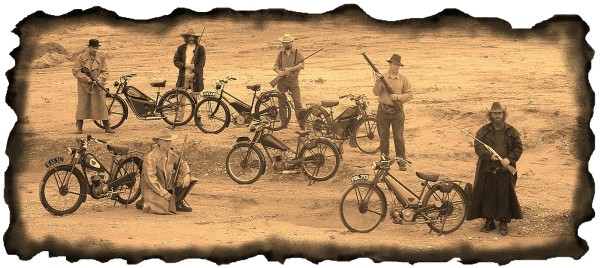
On September 3rd 1880, as Long Riders of The James Gang were holding up a stagecoach for $1,800 at Mammoth Cave, Kentucky, half a world away Harry James (no relation) was opening his James Cycle Company at Constitution Hill, Birmingham to build penny-farthing bicycles. While Jesse was being gunned down by Bob Ford on 3rd April 1882, fortunes were faring much better for Harry; business was thriving! By 1897, Harry was happily retiring on the proceeds as his company went public, and James Cycles went on to build its first motor cycle in 1902.
James took up G H Jones's licence to build pedal cycles propelled by the 98cc Villiers Junior engine and launched its new J18 motorised bicycle in 1938. Cyc-Auto, Raynal, Excelsior and Coventry Eagle were also making similar machines ,but no one had really come up with what to actually call them! It was James who first coined the generic term "Autocycle", which became adopted for the breed thereon. The K18 continued for 1939, and a Tradesman's version was also listed. For 1940, the L18 was joined by an L20 de Luxe version with engine covers.
The factory was bombed out in December 1940, but back up and running again within only 3 months, producing shell cases, aircraft parts, military lightweight (ML) motor cycles and even a few autocycles for "essential service workers". Returning to general sale in 1946, the autocycle now featured sprung tubular girder forks, Villiers Junior de Luxe motor - and a splendid new name: the "Superlux"!
With the advent of a 2F engined Superlux model for the 1949 season, the last JDL stocks to be cleared became re-titled as the "Standard", since both machines could be found on sale during the same year. The Superlux 2F benefited from sharing a number of common components with the new Comet motorcycle and, compared to many traditional autocycles, was a veritable styling revolution! The unusual humpback loop frame didn't look so odd once the elegant teardrop petrol tank was hung beneath it, while the styled taillight bracket blends beautifully into a Wipac series 156 lamp unit. Those are the parts you really notice, while the rest is pretty conventional.
Tracking down The James Gang to their "Hole in the Wall", out in the wild deserts of East Anglia, allows privileged access to practically every James autocycle model, so we might as well look at them all now we've got them cornered!
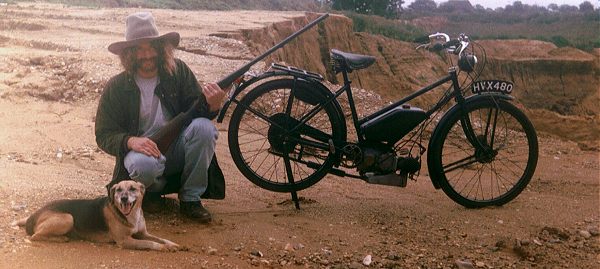
![]()
First up for test is HVX 480, a 1938 J18 Villiers Junior powered veteran. This much-travelled machine is a former two-time Rando Cyclos campaigner, having actually been ridden all the way to Sars Poteries for one of the events! It's also a special example in being the subject of some mysterious tuning in its time, with a 3/8" aluminium lifting plate under the barrel, though further details of what else has gone on inside the motor is not known. It may start easily and run steadily with a smart cracking exhaust note but, when you ride it up the road, the devastating vibrations that come through the pedals are so shattering that you are driven to lift your feet off for relief! It's necessary to get the motor well hot to clear all manner of misfiring and deliver best performance, which was paced at 33mph on the flat and 35mph downhill. Pre-war Juniors are probably not ordinarily expected to achieve such dizzying speeds, at which the test pilot is hanging on to the vibrating handlebars for grim death, as all hell seems to be breaking loose below! The rigid fork and frame rode quite smoothly on good tarmac, but the pilot, thankful to have survived this far, decided to skip the rough surface trial since the result was going to be obvious enough. The antique brakes don't really stop in any normal sense of the term, they just sort of slow it down gradually! Characteristics of the deflector design Junior motor is that it slogs steadily up hills and is actually fairly acceptable if used at moderate speeds (25mph). Accompanying riders say the J18 sounds great, but the pilot's impression may be a little different!
![Ted Riceman [ex Culpattle Pepper Co] and 1949 Superlux JDL](arc0539k.jpg)
![Caption: 'Mister, yew ain't goin' nowhere 'til you've met the James Gang' - Ted Riceman [ex Culpattle Pepper Co] and 1949 Superlux JDL](arc0539c.png)
Second up is FBL 713, a 1949 Superlux Junior de Luxe machine. After the earlier rigid machines, it was probably a luxury for the post-war purchaser to observe the novelty of the headlamp ahead bobbing up and down on the coil sprung fork as the suspension operates. Vibration is less aggressive than on the Junior, though noticeable through the pedals, and at the handlebars if you're not wearing gloves. When the motor comes under load, particularly pulling up a hill, there is a very obvious increase in vibration effects. A pedal assisted take-off becomes fairly standard practice since acceleration is more of a ponderous lumbering up to speed, then approaching full-tilt every- thing is clonking away like an ancient steam traction engine, rattling vibrating tinware and thrashing,whirling chains. Brake linkages are reversed on this model with the left lever operating the poor front brake. There is a lever on the right handlebar, but this doesn't seem to have any connection with rear braking function. Once again,the test pilot is thankful to survive, and our pace bike records best speed at 33mph.
![1950 Superlux 2F UXG 154, Neil Morley [front] and Paul Nelmes](arc0539l.jpg)
![]()
First Superlux 2F is UXG 154, an example dating from early in 1950, it features the old style narrow fork set and still has the limiter pin in the carb top. (When Villiers introduced the 2F and fitted it with the Junior carb, it seems they may have been concerned about the motor over-revving. Most original 2F carb tops were fitted with a 3/32" limiter pin to restrict slider opening to 80%). Pace bike recorded 34mph on the flat in light tailwind with rider prone, and 37mph downhill. A nice smooth ride with very little vibration, good balance, good brakes both ends, and a confi- dent strong exhaust tone from the original factory silencer. The only observation would be that the girder fork felt hard-sprung on a bumpy surface and made the front end rather pitchy, but a really nice riding machine.
![Superlux 2F WAS 582, Paul Nelmes [front], Laurence Coates and Andrew Pattle](arc0539m.jpg)
![Caption: Superlux 2F WAS 582 with Paul Nelmes [F] Laurence Coates & Andrew Pattle](arc0539e.png)
Second Superlux 2F is WAS 582, dating from later in 1950, and differing from the previous machine with the new wider girder fork set and limiter pin ground from the carb top. It features the original pull-back handlebar set, which provides a pleasant position and feels very comfortable on the especially large sprung saddle. Pace vehicle recorded 35mph on the flat in still air with rider upright, and 38mph downhill. Vibrations readily come in through the pedals initially, then further waves of vibes at the handlebar grips as this bike comes under load - typically when pulling uphill. The James coil sprung girder fork transmits a pitchy ride on any bumpy road surfaces and, coupled with a steady battering from the rigid rear, the pilot is going to find this machine quite fatiguing. Both brakes were poor on this example: the front one creaked, and the rear was made all the more difficult to operate in conjunction with positioning of the clutch lock-off lever. Any exhaust tone is completely stifled by the new Armour's pattern silencer, while all the vibrating, rattling cycle parts and mechanical engine sounds become even more apparent. A rider of this machine is likely to tire before the engine does!
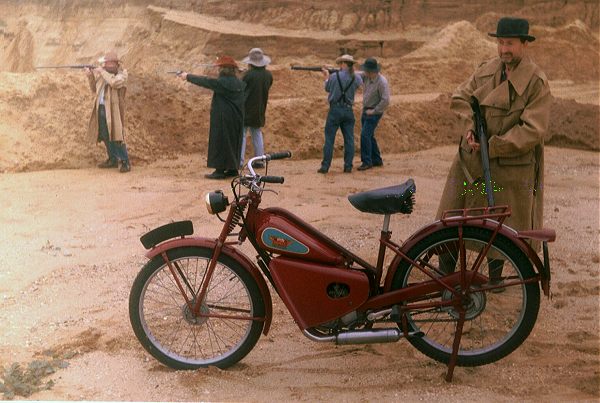

On to a further evolution of the James autocycle, which dates from later in the same year. Though looking much the same as the preceding Superlux 2F, this revision features a lower saddle tube, modified frame with lower angle rear stays, and different rear mudguard to suit. The toolbox is also moved over from the left to the right-hand side, and the mounting changed to suit. The same 2F motor is installed, but OSK 997 immediately impresses as very strong, confidently pulling away without any request for pedal assistance. The firm pulse of the exhaust note emphasises this with its muffled beat in the low range, merging to a resonant drone at speed. This example proves practically vibration free right up its range, recording 35mph on the flat with a light tailwind, and 40mph downhill - quite impressive considering the limiter pin is still fitted in the carb top! Unlike some other autocycles, the "stay clean" engine covers are pleasantly in proportion with the rest of the bike, with a nice flare at the front to provide semi-practical weather protection for the shins; unfortunately they also seem responsible for producing some irritating metallic resonation at speed. The front brake was fairly poor, while the rear brake was very poor. A fine example to ride,but requires some anticipation of what's going on ahead.
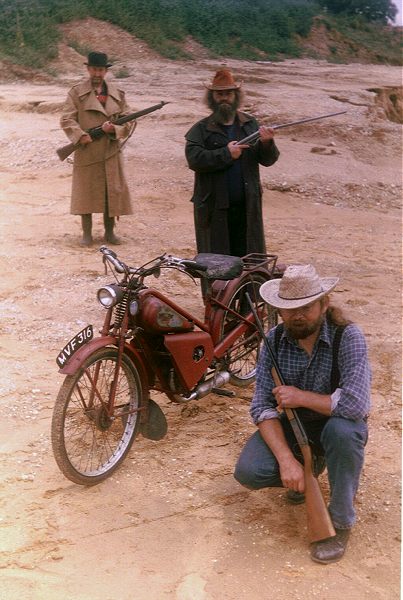

MVF 316 is our final machine, a battered old cam- paigner, again registered in late 1951, and it's actually only 30 numbers up the frame series on the previous example! The rear stand clip doesn't work,so the stand has to be tied up with a rubber band. Since the clutch drags, it proves too difficult to tie up the stand with the engine running, so it appears more practical to pedal-start it along the road. This also proves tricky since the decompressor cannot be reached to hold it in as the clutch is released. The carb top has no limiter pin, but doesn't show any advantage as the motor seems to level out at a paced 33mph on the flat. The front brake (on the left lever)is pretty poor, and made even more difficult to operate as the lock-off clutch lever partially blocks it from above. What's meant to be a back brake (on the right lever), has no effect whatever! Despite these faults, it sounds healthy, pulls away quite strongly, and rides surprisingly well. We catch a tailwind on the return leg of the test and go for max along the straight ... 33 ... 34 ... 35 ... then the engine suddenly falls silent and we skid to a stop with the back wheel locked! Er, slight heat seize I think? Release the clutch again and nudge the motor backward, then pedal away and the engine fires up once more, so we cruise cautiously back to base. Everything feels OK, but after a nip-up, it's always best recommended to pop the top end off just to make sure. This ride was relatively untroubled by vibration, and even the sidepanels didn't buzz, mind it was noted that an additional stay bracket had been added from the frame across the top front. Not a case of saving the best machine till last!
Something spooks them, and to a crackle of exhausts and drifting cloud of smoke, The James Gang melt away into the sunset,so we return to the archives to close the tale.
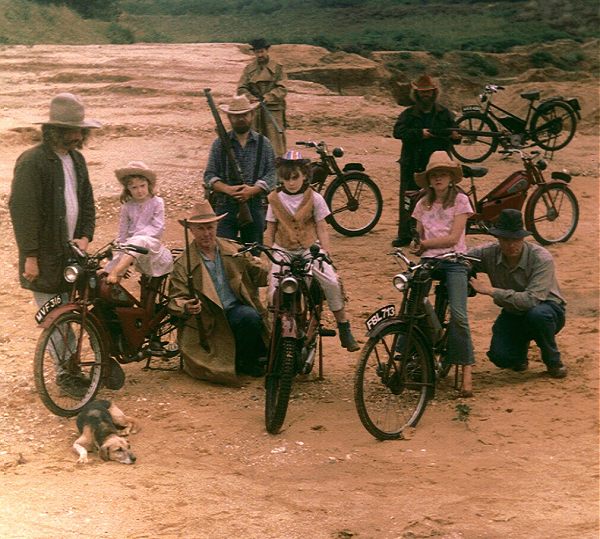
![]()
Various models of James autocycles had been steadily selling around 2,000 machines per season up to 1951 when this fell to 1,286. The decline in sales continued and 1952 recorded only 773 autocycle units over the year. Introduced from September of '52, the Superlux 2F became re-designated as model J1 for the 1953 season. This was basically the same bike with the toolbox deleted and blue panels discontinued from the petrol tank transfers. '53 proved even worse, and AMC Group struck its last autocycle from the lists in July of 1954 after a mere 320 J1s had been sold over the last 18 months!
Next issue: Strolling forward down the corridor of time - "1958". The last autocycle became extinct in July. The moped war is heating-up, and a new contender is about to join the battle. These are troubled times! We feel the cold iron handle in our palm...
First published, October 2004